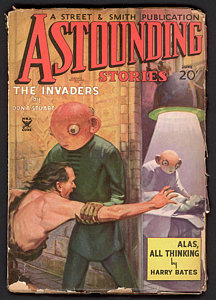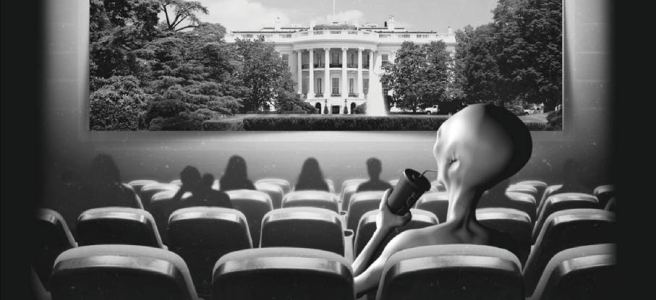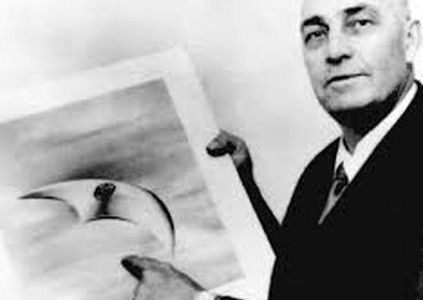I tend to being caustically critical of folks who don’t do their homework, and, as is only just, I have fallen prey to a failing I loathe.
Thanks to no little impetus from M. J. Banias, I essayed some thoughts on UFOs and hyperreality, developing a fourfold distinction between the real, the Real, the hyperreal, and the hyporeal. I noticed after publishing these reflections, one reader of Skunkworks had followed a hyperlink in a previous posting of mine to an article on Mysterious Universe by Robbie Graham, “UFOs: Fact, Fantasy, and Hyperreality”, a version of the conclusion to his 2015 book Silver Screen Saucers. I therefore address here Graham’s treatment of this topic, in the spirit of intellectual honesty and rigor, and to give credit where credit is due.
First, I attempt to reconstruct his views on UFOs, mass media (particularly cinema or the televisual), and the hyperreal as coherently and persuasively as I can….
Graham derives a version of the hyperreal via a genealogy that begins with Walter Benjamin’s “The Work of Art in the Age of Mechanical Reproduction”, which then descends by way of Guy Debord’s The Society of the Spectacle to arrive at Jean Baudrillard’s Simulation and Simulacrum, the locus classicus of the concept of the hyperreal (though, strictly, Baudrillard first essays the idea in his earlier book, Symbolic Exchange and Death). Graham’s own understanding is expressed very hastily; he synthesizes Benjamin, Debord, and the Wikipedia entry on ‘Hyperreality’ (hardly the most trustworthy authority), in a single sentence:
Technologies of reproduction (mechanical and digital) have ushered in the age of the hyperreal, an age where simulations of reality threaten to dissolve the boundaries between “fact” and “fantasy,” between “true” and “false,” “real” and “imaginary.”
This “age of the hyperreal” emerges from the conditions of the society of the spectacle, which Graham characterizes as one wherein
…“the real world changes into simple images… and the simple images become real.” In our spectacular society [sic], said Debord, “the image matters more than the object, in fact, much more so than mere objective truth.” The image replaces the truth – it is truth, it is reality.
Such hyperbolically paradoxical claims—that reality becomes image; images, real; that they replace truth and reality; that the distinctions between fact and fantasy, true and false, and real and imaginary threaten to collapse—call for some explanation, let alone support, which I imagine Graham sees himself as providing in the remainder of his text, which sets out his main contention that
cinematic simulations of UFOlogical history have all but consumed the history itself through the process of replication, just as humans were consumed and replicated as pod people in genre classics such as Invasion of the Body Snatchers (1956) or John Carpenter’s The Thing (1982).
This “process of replication” and replacement depends upon the power of cinema and how the medium takes up and presents “real” ufological material. For Graham, UFOs “are ‘real,’ … they exist independently of cinema, and of pop-culture”; UFO phenomena precede their pop cultural representation, and, even in the absence of this representation “people would continue to report UFOs.” Cinematic fictions are therefore based on ufological facts (“art imitates life”); however, because of the artistic license taken with these facts and the power, aesthetic and social, of the medium, the public perception of the “real” phenomenon is distorted if not replaced by its fictional versions.
Graham’s insight turns on the power he grants the cinematic medium:
Movies masquerade as the final word on a given topic. No matter what the subject, and regardless of how much that subject has already been written about and debated, once it is committed to film—once it has received the full Hollywood treatment—it is embedded firmly and forever into the popular consciousness. Imprinted on our psyche. Plunged into the deep wells of memory and imagination.
This power is troubling, since cinema “imprints” on its audience not the truth of reality but “at best, reflections of …reality, snapshots of it, simulations of it, skewed and distorted through the ideological framework of those who have made them.”
Based on these premises, Graham analyzes the general process of hyperrealization into three phases. First, authentic, true, real ufological material is simulated in some popular medium (film, television, or “video games, comic books, etc.”). Second, the audience receives this simulation and is consequently subject to the workings of popular media by which the source material, “ufological reality” “is masked and perverted”. Finally, “reality and simulation are experienced as without difference, or rather, the image has come to mean more … than any underlying reality.”
He summarizes the process thusly:
Essentially, then, the hyperreality of the UFO phenomenon has arisen primarily through processes of mass media simulation. The blurring of true and false, real and imaginary, through that most magical of mediums (cinema), and within the context of that most fantastical of genres (science fiction), engenders our acceptance of the UFO as just that: a fictional media construct with little or no grounding in our lived historical reality. And yet, thanks to their permanent residency in the popular imagination, UFOs are no less real to us as a result.
To paraphrase: I take Graham to mean that the mass media exploitation of ufological material—its re-presentation, reproduction, and proliferation—overwhelms the preexisting, real-world sightings and encounters, drowning out and replacing that UFO reality in the public imagination. Because the ufological thereby becomes in the first instance a matter of fantasy and more-or-less light entertainment, whatever gravity the real-world phenomenon might possess is coloured by its media representation in advance, prejudicing its reception. In this way, the representation takes precedence over the represented.
I find Graham’s basic point, as paraphrased above, persuasive; however, there are some nits to pick and more major implications to unfold. A slight parody of Marshall McLuhan’s famous pairing will organize our critique according the media and their messages.
The aesthetic and social power of cinema in particular and mass media in general are central to Graham’s views. On the one hand, he’s surely correct to stress the power of the medium, the way the audience, especially when films were generally viewed on a big screen, can lose itself in the film, like a dream, as director David Lynch so eloquently remarks, a potential that also inspires directors as different as Quentin Tarantino and Guy Madden, following the example of Benjamin’s contemporary, Bertolt Brecht, to adopt techniques precisely to break that trance. But is it true that movies pretend to give “the final word on a given topic,” that once a subject “is committed to film it is embedded firmly and forever into the popular consciousness”? Here, I think Graham overstates his case to drive home the way cinematic representations can take on a life, truth and reality of their own, e.g., the image of the Wild West (ironically returned to an explicitly fictional status by that sleeper of recent years, Gore Verbinksi’s The Lone Ranger). More importantly, however, is the way that paradoxical active passivity of the audience in its suspension of disbelief is passed over in silence: like the subject of hypnosis, the audience must want to enter the cinematic or other world presented by the medium where it then becomes subject to its influence; the effects of media on their audiences are less one-way than Graham’s characterizations would admit.
Moreover, Graham places too much importance on the cinematic or televisual media. Surely, when Kenneth Arnold made his historic sighting report, print media (where it first appeared) still held its own against Hollywood. Within two decades the small screen of the television was giving the big screen a run for its money. Within a generation, the internet and digital media began their revolutionary drive to dominance, and now, twenty or so years later, the smart phone is the the premiere medium. Admittedly, the proliferation of such essentially televisual media strengthen Graham’s case for the insidious influence of popular culture.  However, at the same time, he underestimates or discounts the popular culture presence of UFO and alien imagery preceding Arnold’s monumental sighting, as scholars and skeptics as diverse as David Halperin and Martin S. Kottmeyer would be glad to point out with gusto. In a telling, figurative slip, Graham himself seems to grasp that other media decentre cinema, when he writes that cinema provides only “snapshots” of reality; the older, static medium of photography intrudes synecdochally into the characterization of its newer, dynamic competitor if not replacement, both as its forerunner and essential element (pre-digital “film” being a sequence of still shots…).
However, at the same time, he underestimates or discounts the popular culture presence of UFO and alien imagery preceding Arnold’s monumental sighting, as scholars and skeptics as diverse as David Halperin and Martin S. Kottmeyer would be glad to point out with gusto. In a telling, figurative slip, Graham himself seems to grasp that other media decentre cinema, when he writes that cinema provides only “snapshots” of reality; the older, static medium of photography intrudes synecdochally into the characterization of its newer, dynamic competitor if not replacement, both as its forerunner and essential element (pre-digital “film” being a sequence of still shots…).
Here, the artefactual record is the first to rub against his assertion that the UFO phenomenon precedes and transcends its popular cultural representations. More seriously, his three-phase process is curiously atemporal and abstract. The UFO witness is no blank slate, but oriented within and informed by culture, just as Hollywood is guided not only by existing artistic conventions and material conditions (funding, market, audience expectations, etc.) but by the canon of existing UFO/alien depictions, which themselves become material to be reproduced or transcended (by new material or radically different depictions and development). In other words, there is no immaculate UFO experience not already influenced by popular culture, just as there is no pure cinematic medium untouched by tradition or the present that takes up this experience as material. The experience and its mass cultural representations are always already mutually implicated.
Most importantly, there is marked tension between the claims that “reality and simulation are experienced as without difference” and that the “real” UFO experience precedes and transcends its variegated pop cultural simulations. Graham goes to great lengths to maintain that, on the one hand, art imitates life, that “art” masks and perverts “life” (otherwise he couldn’t mount his criticisms of the way the media of mass culture undermine and overthrow UFO reality in the popular understanding and imagination), while, on the other, the society of the spectacle and our hyperreal present “dissolve the boundaries between ‘fact’ and ‘fantasy,’ between ‘true’ and ‘false,’ ‘real’ and ‘imaginary’.” Uncharitably, we could accuse Graham of incoherence and move on, but a more informed understanding might argue his thinking has fallen prey to a process that bedevils not only attempts to maintain a rigid binary opposition but, in this case, to collapse such oppositions. In either case, the very logic that would oppose two terms, if rigorously followed through, will show how each inseparably implicates the other, while here, the logic that would dissolve difference inescapably reinscribes it.
Graham’s main insight, that UFO reality is displaced both in its character (its “image”) and import (meaning) by its mass cultural fictional representations is well-taken, to a point. What’s absent is a more profound appreciation for how the UFO phenomenon is caught up in mass media in general, whether factual or fictional, and how both the “real” experience of the phenomenon and its representation in whatever medium mutually inform each other at the source. The conflict, then, is not so much between life and art as between competing media representations. Graham’s argument is premissed on Baconian, pre-semiotic (strictly, pre-1800!) assumptions about representation, that a self-sufficient, ready-made world precedes and transcends our perceptions and representations of it, whose accuracy depends upon how closely they correspond to their original.
More seriously, the question as to why the “real” phenomenon is perverted in just the ways it is needs be addressed (which, I believe, is part of the purpose of the book his reflections on the hyperreality of the UFO conclude). One answer would point to the commodity form, the way under capitalism everything imaginable is harvested, processed, packaged, and marketed, from DNA to data. This reflection might reveal why representations of either the “real” phenomenon or its fictional representations mask, pervert, “skew and distort” the UFO, not “through the ideological framework” of those who produce these factual or fictional representations, but precisely because of or as the ideology within which the UFO is encountered and that encounter communicated (sold).



 However, at the same time, he underestimates or discounts the popular culture presence of UFO and alien imagery preceding Arnold’s monumental sighting, as scholars and skeptics as diverse as
However, at the same time, he underestimates or discounts the popular culture presence of UFO and alien imagery preceding Arnold’s monumental sighting, as scholars and skeptics as diverse as 


